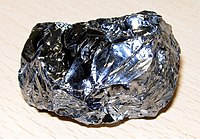
Photo from wikipedia
Detection of nitroaromatic explosives is of strong concern because of human health, public safety, environment, and military issues. In this study, we present a ratiometric sensor array for detection and… Click to show full abstract
Detection of nitroaromatic explosives is of strong concern because of human health, public safety, environment, and military issues. In this study, we present a ratiometric sensor array for detection and discrimination of widely-used nitroaromatics (i.e., 2,4,6-trinitrotoluene (TNT), 2,4,6-trinitrophenol (TNP), and 2,4-dinitrotoluene (DNT)). In the design of sensor elements (SE) we employ blue emissive carbon dots (BCDs) in combination with yellow (SE-A) and red (SE-B) emissive cadmium telluride quantum dots (CdTe QDs). The fluorescence intensity of BCDs, YQDs, and RQDs is quenched by TNT, DNT, and TNP in various degrees. Both TNT and TNP cause the quenching and spectral shift of BCDs (TNT causes a blueshift and TNP causes a redshift). However, DNT has no effect on CDs emission. The developed double-emitter sensor array is capable of discriminating nitroaromatics in the concentration range of 5.0-200.0 μmol L-1 with a limit of quantification as low as 5.0 μmol L-1. In addition, the sensor array demonstrates a promising capacity to detect structurally similar nitroaromatics in mixtures and complex media of soil and groundwater samples.
Journal Title: Talanta
Year Published: 2019
Link to full text (if available)
Share on Social Media: Sign Up to like & get
recommendations!